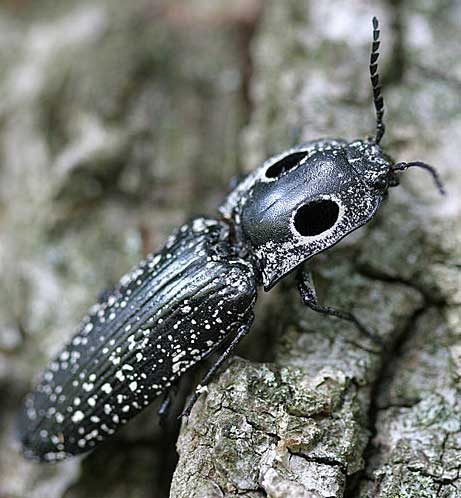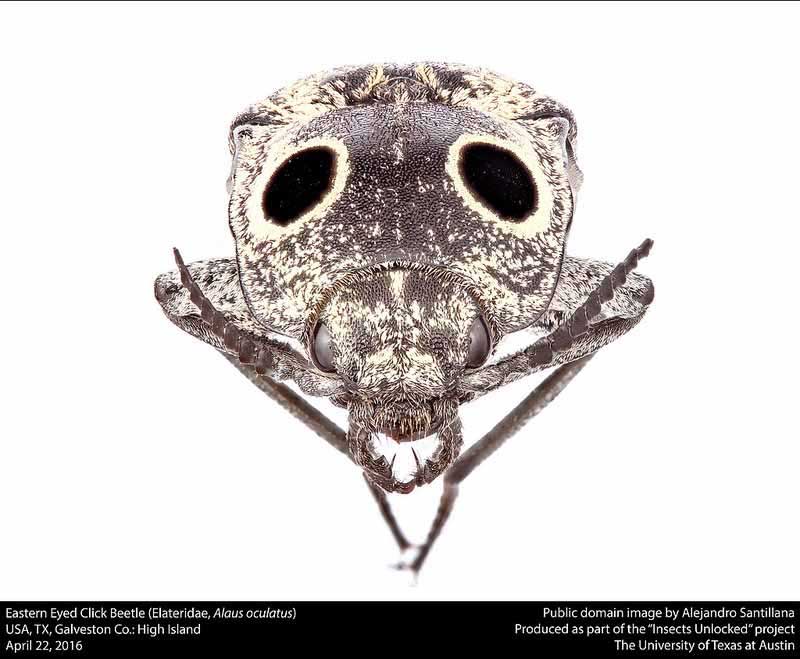
Eyed click beetle Alaus oculatus, Poolesville, Maryland, USA (*)
Superregnum: Eukaryota
Regnum: Animalia
Subregnum: Eumetazoa
Cladus: Bilateria
Cladus: Nephrozoa
Cladus: Protostomia
Cladus: Ecdysozoa
Cladus: Panarthropoda
Phylum: Arthropoda
Subphylum: Hexapoda
Classis: Insecta
Cladus: Dicondylia
Subclassis: Pterygota
Ordo: Coleoptera
Subordo: Polyphaga
Infraordo: Elateriformia
Superfamilia: Elateroidea
Familia: Elateridae
Subfamilia: Agrypninae
Tribus: Hemirhipini
Genus: Alaus
Species: Alaus oculatus
Name
Alaus oculatus (Linnaeus, 1758)
Synonyms
Basionym: Elater oculatus

References
Primary references
Linnaeus, C. 1758. Systema Naturae per regna tria naturæ, secundum classes, ordines, genera, species, cum characteribus, differentiis, synonymis, locis, Tomus I. Editio decima, reformata. Holmiæ: impensis direct. Laurentii Salvii. i–ii, 1–824 pp DOI: 10.5962/bhl.title.542: 404. Reference page.
Additional references
Casari, S.A. 2002: Larvae of Alaus myops, A. oculatus, Chalcolepidius porcatus, Hemirhipus apicalis and generic larval characterization (Elateridae, Agrypninae, Hemirhipini). Iheringia, Série Zoologia, 92 (2): 93–110. PDF
Woodruff, R.E. 1999 (revised 2004): Click Beetles, Alaus spp. (Insecta: Coleoptera: Elateridae). Document EENY-085, 5 pp. University of Florida IFAS Extension. PDF
Links
ZooBank: 50AA5C04-0D9D-458B-99F1-51BCA7CFE44F
Vernacular names
English: Eyed elater, eyed click beetle
Alaus oculatus, commonly called the eastern eyed click beetle or eyed elater, is a species of click beetle.
Alaus oculatus, preserved specimen
Description
Alaus oculatus can reach a length of about 25–45 millimetres (1.0–1.8 in).[1] They have an elongated body, black in color throughout. The pronotum exhibits a large oval patch of darker scales, framed in white, on each side - the common name of the beetle derives from this feature. The elytra are striated and mottled with silvery whitish scales.[1][2][3] The "false eyes" depicted on the pronotum are a defensive adaption that has evolved because of its advantage confusing or frightening potential predators. The eyespots are a form of self-mimicry, in which one part of the body has adapted to mimic another body part. Like all click beetles, A. oculatus is also capable of suddenly catapulting itself out of danger by releasing the energy stored by a click mechanism, which consists of a stout spine on the prosternum and a matching groove in the mesosternum.[4]
Life cycle
Eggs are laid in soil or on standing deadwood. Many larvae from the click beetle family Elateridae are commonly referred to as wireworms and are prominent agricultural pests that feast on plant matter. However, the larvae of Alaus oculatus are unique among wireworms because they are predatory to other beetle larvae feeding in decaying wood, especially Cerambycidae.[1] The larva pupate in rotting logs or below the ground and the adults emerge in the spring and are commonly found until September.[5]
Diet
The adults do not eat much but their diet consists of nectar and plant juice. The larvae diet consists of grubs of wood-boring beetles.[3] The larvae are voracious on wood borers, and that during their development caged specimens were observed to devour more than 200 cerambycid larvae each.[6]
Distribution and habitat
This species is present in Central and North America.[1] It can be found in deciduous/mixed forests and woodlands.[3]
References
R.E. Woodruff (2014). "Featured creatures: Alaus spp". University of Florida. Retrieved 2017-07-13.
"Eyed click beetle (Alaus oculatus) (Linnaeus, 1758)". Forestry Images, The University of Georgia. Retrieved 2017-07-13.
"Species Alaus oculatus - Eyed Click Beetle". BugGuide.net. 2016. Retrieved 2017-07-13.
Evans, Arthur V.; Bellamy, Charles (2000). An Inordinate Fondness for Beetles. University of California Press. pp. 27–28. ISBN 978-0-520-22323-3.
Borror, D., R. White. 1970. Peterson Field Guides. Insects. Boston: Houghton Mifflin Company.
Craighead FC. 1950. Insect Enemies of Eastern Forests. U.S. Department of Agriculture Miscellaneous Publication 657: 1- 679.
Retrieved from "http://en.wikipedia.org/"
All text is available under the terms of the GNU Free Documentation License

